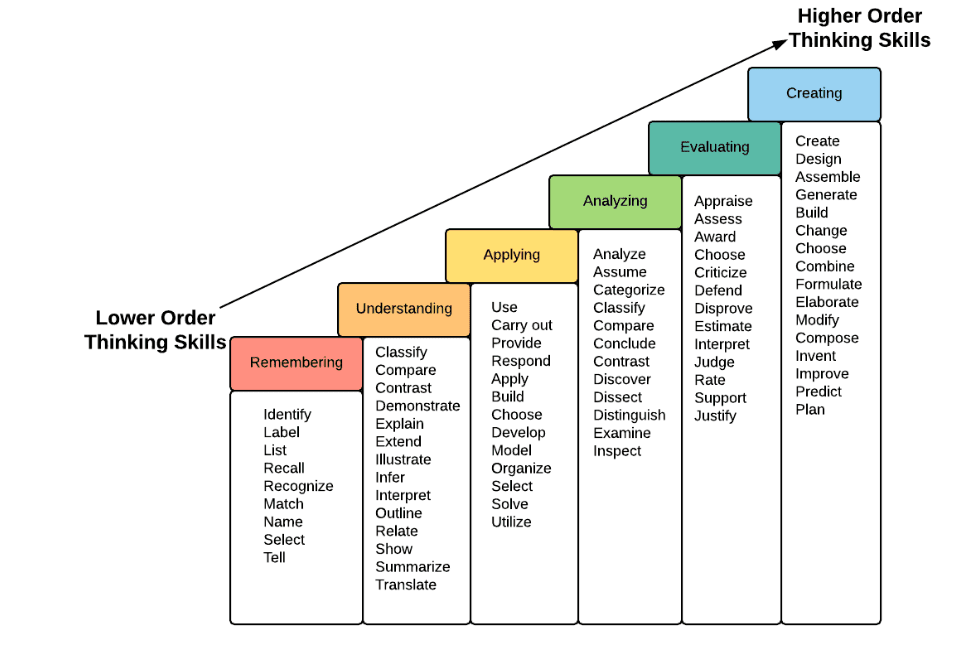Writing Measurable Course Objectives
What is a course objective?
A course objective specifies a behavior, skill, or action that a student can demonstrate if they have achieved mastery of the objective. As such, objectives need to be written in such a way that they are measurable by some sort of assessment. Course objectives form the foundation of the class. Everything in the course should work together to ensure students master the course objectives.
What do good course objectives look like?
Good course objectives will be specific, measurable, and written from the learner’s perspective. Here’s a good formula for writing objectives:
-
Start your course objectives with: By the end of the course, students will be able to:
-
Choose an action verb that corresponds to the specific action you wish students to demonstrate
-
Explain the knowledge students are expected to acquire or construct
-
[Optional]: explain the criterion or level students are expected to reach to show mastery of knowledge
-
You will also want to make sure that you have thought of a way to assess students’ learned knowledge when writing course objectives. For example, if you always test students’ knowledge of content matter with a multiple choice test, the course objectives cannot ask that students evaluate or create something, as multiple choice tests cannot assess those levels of learning with a high level of accuracy.
![Context for Subject Matter This fill in the blank example can help put this into context for your own subject matter: If students have learned [knowledge/subject of the course], then the should be able to [specific action students can do if they know the content] by completing [assessment/proof of knowledge]. Example: If students have learned US History since 1865, then they should be able to explain the effect of immigration on American culture by completing an essay comparing and contrasting the effect of two immigrant populations on American culture from 1865-1900.](https://teaching.charlotte.edu/wp-content/uploads/sites/885/2023/11/Tf2JdTxflO75Am9ql8g-v9zjzqIMAYhTZECgo8QnlkgODcVPWBI-ELq2kWEOQ_ckEO1neoS7c4Z3TSmy7dREylxSrPco4AMvjDE92SiZ_GRDUlH2iLDhNEJTzqqf1_nUG1aqZMHG.png)
If you cannot logically fill in the last blank of this example (assessment), then the objective is not measurable. You won’t include the assessment in the text for your actual course objective that you publish on your syllabus, but you need to know if what you’re asking students to know can be assessed. Otherwise, how can you know or prove that students have learned what they’re supposed to learn in your course?
Difference between Objectives and Assessments:
One thing that can be confusing when creating course objectives is the difference between what students are being asked to know and the assessment that is used to “prove” that students know the information. In the example above, it may be tempting to write something like this: If students have learned U.S. History since 1865, then they should be able to write an essay comparing and contrasting the effect of two immigrant populations on American culture from 1865-1900.
This objective seems measurable, but it’s saying that by the end of the class “students should be able to write an essay”. That makes it sound like one of the objectives of the course is for students to write an essay. What students really need to know though is the effect of immigration on American culture. If you use the assessment in the “course objective slot,” the knowledge students need in order to complete the assessment is assumed rather than explicitly stated.
This could cause issues with the creation of materials and activities in your units because the focus may be on teaching students how to write essays rather than teaching them about the effect of immigration on American culture during a specific time period.
Bloom’s Taxonomy:
Using a taxonomy that explains different levels of learning can be helpful for selecting the appropriate action verbs for your course objectives. These will help prevent you from choosing lower order actions when you really want students to demonstrate higher order thinking.
Bloom’s Taxonomy is broken into six knowledge dimensions: Remembering, Understanding, Applying, Analyzing, Evaluating, and Creating and range from lower order thinking skills to higher order thinking skills.
By their very nature, higher order thinking skills are more difficult and build on the previous lower order thinking skills. An oversimplified explanation of this would be the following: A student can not be expected to create a design brief (Creating) if they can’t remember what a design brief is (Remembering).
Traditionally, entry level courses ask students to demonstrate remembering, understanding, and applying thinking skills with a few higher order thinking skills while graduate level courses ask students to demonstrate analyzing, evaluating, and creating thinking skills with a few lower order thinking skills.

How do course objectives differ from module objectives?
Course objectives are much broader in scope than module level objectives. Where module objectives break down skills and knowledge into very specific, discrete skills, course objectives point more to overarching student understanding and higher level thinking skills. In a unit, you may have 10 or more objectives explaining all of the steps/tasks involved in learning a concept. For a course, you will only want 3-6 course objectives.